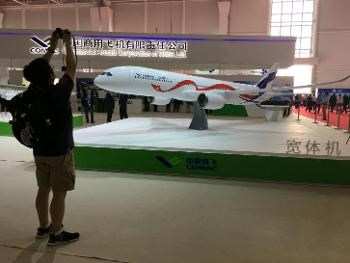Is the market ready for another widebody aircraft?
This past week, the Airshow China 2016 event was held, from November 1 – 6 in Zhuhai, China. A notable outcome from the show, reported in several media outlets, was that Russia’s United Aircraft Corp. (UAC) and the Commercial Aircraft Corporation of China (COMAC) have advanced their plans for their collaborative twin-aisle widebody aircraft.

This photo from Ooyuz Web site shows the model of a UAC/COMAC joint venture widebody aircraft, at the Airshow China 2016 in Zhuhai.
This past week, the Airshow China 2016 event was held, from November 1 – 6 in Zhuhai, China. A notable outcome from the show, reported in several media outlets, was that Russia’s United Aircraft Corp. (UAC) and the Commercial Aircraft Corporation of China (COMAC) have advanced their plans for their collaborative twin-aisle widebody aircraft, so far referred to as Long-Range Wide-Body Commercial Aircraft (LRWBCA). A mockup of the new aircraft was on display at the show, showing 280 seats and 9-abreast economy seating.
An agreement was initially signed in 2012 between UAC and COMAC to study the feasibility of a widebody to compete with Boeing and Airbus. At the China air show event last week, COMAC released a document saying that it and UAC have progressed to a joint venture, to be based in Shanghai, which will start operations this year, presumably on initial designs and supplier agreements, says a Reuters market news story dated Nov. 1 by Brenda Goh and Kenneth Maxwell.
According to a Nov. 4 Aviation Week & Space Technology article by Bradley Perrett and Maxim Pyadushkin, UAC will build the aircraft’s composite wing, using the technology developed by AeroComposit (Moscow, Russia) for the Irkut MS-21 single-aisle commercial transport (see our story on that composite wing technology involving dry layup and infusion here: http://www.compositesworld.com/articles/resin-infused-ms-21-wings-and-wingbox). COMAC will make the fuselage, using both aluminum and composite, with final assembly to occur in Shanghai, according to the article. Power will be provided by Rolls-Royce or General Electric engines, with a possible Russian engine to be developed by 2030. Projected entry into service will be 2027, say the authors.
The joint venture is apparently focused on replacing the Airbus 330, as that aircraft ages over the next decade, and the Perrett and Pyadushkin article says that UAC and COMAC are claiming a 10% advantage in operating costs over competing models. Recent acquisitions of aircraft manufacturing technology and equipment companies by Chinese entities, including Brotje Automation (Rastede, Germany), Kuka Aerospace (Clinton Township, MI, US) and Aritex (Barcelona, Spain), indicate that COMAC will likely have access to experienced worldwide suppliers for high-tech assembly.
So will a new Chinese/Russian market entrant succeed, especially one with a composites-intensive design? Only time will tell as the new aircraft’s design progresses. Is the demand there for a new widebody aircraft in the current market? Another Aviation Week article dated Nov. 4 by Joe Anselmo cites a maintenance, repair and overhaul (MRO) market survey that shows weak demand for current wide-body aircraft (e.g., Boeing 777, 747, Airbus A380), with no sign of improvement. On the other hand, Airbus’ 2016 – 2035 Global Market Forecast report claims that China will need nearly 6,000 new passenger aircraft and freighters during that time period. The forecast projects 4,230 single aisle planes and 1,740 widebody planes for China, to meet what Airbus says will be the fastest-growing air passenger market, well above the rest of the world.
Related Content
Composites end markets: New space (2025)
Composite materials — with their unmatched strength-to-weight ratio, durability in extreme environments and design versatility — are at the heart of innovations in satellites, propulsion systems and lunar exploration vehicles, propelling the space economy toward a $1.8 trillion future.
Read MoreFilament winding increases access to high-performance composite prostheses
Steptics industrializes production of CFRP prostheses, enabling hundreds of parts/day and 50% lower cost.
Read MoreCarbon fiber, bionic design achieve peak performance in race-ready production vehicle
Porsche worked with Action Composites to design and manufacture an innovative carbon fiber safety cage option to lightweight one of its series race vehicles, built in a one-shot compression molding process.
Read MoreAn outlook on China’s carbon fiber market
This analysis sheds additional light on the insights, observations and data shared in ATA Industrial Group’s carbon fiber market report on global and Chinese industry players.
Read MoreRead Next
Next-gen fan blades: Hybrid twin RTM, printed sensors, laser shock disassembly
MORPHO project demonstrates blade with 20% faster RTM cure cycle, uses AI-based monitoring for improved maintenance/life cycle management and proves laser shock disassembly for recycling.
Read MoreScaling up, optimizing the flax fiber composite camper
Greenlander’s Sherpa RV cab, which is largely constructed from flax fiber/bio-epoxy sandwich panels, nears commercial production readiness and next-generation scale-up.
Read MoreCutting 100 pounds, certification time for the X-59 nose cone
Swift Engineering used HyperX software to remove 100 pounds from 38-foot graphite/epoxy cored nose cone for X-59 supersonic aircraft.
Read More






















